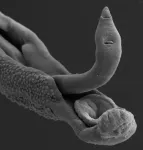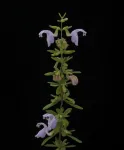(Press-News.org) Researchers in Brazil have used an innovative technique in molecular biology to identify targets for candidate vaccines against Schistosoma mansoni, the parasite that causes schistosomiasis.
Considered one of the world’s 17 neglected tropical diseases (NTDs), schistosomiasis affects some 200 million people in 74 countries, according to the World Health Organization (WHO). Six million are estimated to be infected in Brazil, mainly in the Northeast region and Minas Gerais state.
The scientists used phage display, the study of protein interactions using bacteriophages, viruses that infect bacteria, to screen 99.6% of 119,747 DNA sequences encoding the proteins known to be expressed across all life-cycle stages of the parasite, achieving comprehensive coverage of its proteome.
The results of the study are reported in an article in NPJ Vaccines, an open-access journal published by the Springer Nature group.
They follow on from those of a previous study that revealed the mechanism whereby the Rhesus macaque Macaca mulatta naturally develops a lasting immune response against schistosomiasis by inhibiting certain of the parasite’s genes so that it cannot multiply in the host organism. This immune response leads to self-cure after first contact with S. mansoni and enables the animal to react faster to a second infection (read more at: agencia.fapesp.br/37688).
“Phage display had never been deployed for this purpose in research on parasitic diseases, which normally involves preselection of a few targets for testing of candidate vaccines. In this study, we screened 12,000 proteins of S. mansoni at the same time to identify which ones were targeted by the macaque’s antibodies, both after initial infection and reinfection and after reinfection and self-cure, a key innovation. Both the technique and the model for the study were innovative,” said Murilo Sena Amaral, a researcher at Butantan Institute’s Laboratory of Cell Cycle.
Amaral is the penultimate author of the article. The last author, as principal investigator for the study, is Sergio Verjovski-Almeida, also a researcher at Butantan Institute and a professor at the University of São Paulo’s Institute of Chemistry (IQ-USP).
Both are supported by FAPESP (15/06366-2 and 20/01917-9), which has also funded scholarships for other researchers in the group (18/18117-5, 19/02305-0 and 16/10046-6), including a PhD scholarship for first author Daisy Woellner Santos.
Methodology
The researchers investigated the immune response of ten macaques infected by S. mansoni during the stages of self-cure and resistance to reinfection using a recently developed technique called peptide library-based phage immunoprecipitation sequencing (PhIP-Seq). They constructed a phage display library that comprised 119,747 DNA sequences encoding 11,641 known proteins from S. mansoni in all stages of its life cycle. The library was incubated with antibodies collected from rhesus macaques in a previous study at different points during the process of self-cure and resistance to reinfection. The aim was to isolate and identify specific targets of the animal’s immune response to the parasite.
Library screening with antibodies from the early phase of parasite infection identified significantly enriched epitopes of parasite extracellular proteins known to be expressed in the host’s digestive tract, shifting toward intracellular proteins during the late phase of parasite clearance (released owing to its death). Epitope refers to the specific target against which an individual antibody binds. When an antibody binds to a protein, it bonds not to the entire protein but to a segment known as an epitope.
The enriched peptides were analyzed with bioinformatics tools to identify potential candidates for vaccines. The most promising candidates were tested in a pilot vaccination assay, in which mice were immunized with a selected pool of PhIP-Seq-enriched phage-displayed peptides. The result was a significant reduction of worm burden in the immunized mice.
“You often hear the argument that a schistosomiasis vaccine isn’t feasible, but our discoveries have revealed a great deal of the immune response and opened up promising prospects for the development of an effective vaccine. We worked with the 12,000 proteins key to all stages of the parasite’s life cycle and succeeded in identifying the most reactive targets,” Verjovski-Almeida told Agência FAPESP. The technique can be used for other types of parasite, he added.
In an article published in May 2023, the group described their discovery of a way to “separate” male and female parasites so as to prevent reproduction and egg release. Male-female pairing, with the female living inside the male, is essential to their survival. Without it, they die. In the study, the researchers showed that male-female separation could be obtained by silencing specific long noncoding RNAs (lncRNAs), which are therefore a promising target for treatment of the disease (read more at: agencia.fapesp.br/41908).
How the worm works
Schistosomiasis is a parasitic disease associated with poor hygiene and a lack of basic sanitation. It is transmitted when an infected person excretes feces containing schistosome eggs into the environment. The eggs hatch in freshwater, releasing larvae that infect snails. The snails are intermediate hosts, while humans are definitive hosts.
After four weeks, the larvae leave the snail as cercariae, the free-swimming larval stage. When humans come into contact with contaminated water, they acquire the disease via active skin penetration by cercariae.
In the human bloodstream, the cercariae progress to the schistosomule stage, eventually becoming adult worms that lodge in the veins of the intestines. The first symptoms of the disease appear two to six weeks after infection.
The disease is diagnosed by laboratory analysis of feces. Simple cases can be treated by a single dose of praziquantel, a drug discovered in the 1970s and distributed in Brazil by the national health system (Sistema Único de Saúde, SUS). However, it does not assure continuous protection. Patients taking it can be reinfected, and there are reports of parasite drug resistance.
“The next step is to develop a suitable vaccine formulation containing adjuvants and a novel mechanism for delivery of these antigens so that they produce better protection in the host. We have some targets with higher response levels,” Verjovski-Amaral explained. Butantan Institute has applied for a patent on the group’s discoveries linked to possible vaccine targets.
Oswaldo Cruz Foundation (FIOCRUZ), an arm of the Brazilian Health Ministry, has been working for years on what could be the world’s first schistosomiasis vaccine. Called Schistovac, it is in the testing stage and contains a modified version of the Sm14 protein found in S. mansoni. The protein normally plays a key role in trafficking fatty acids, which are essential to the parasite’s cellular functions. The modified version is designed to prevent proliferation.
About São Paulo Research Foundation (FAPESP)
The São Paulo Research Foundation (FAPESP) is a public institution with the mission of supporting scientific research in all fields of knowledge by awarding scholarships, fellowships and grants to investigators linked with higher education and research institutions in the State of São Paulo, Brazil. FAPESP is aware that the very best research can only be done by working with the best researchers internationally. Therefore, it has established partnerships with funding agencies, higher education, private companies, and research organizations in other countries known for the quality of their research and has been encouraging scientists funded by its grants to further develop their international collaboration. You can learn more about FAPESP at www.fapesp.br/en and visit FAPESP news agency at www.agencia.fapesp.br/en to keep updated with the latest scientific breakthroughs FAPESP helps achieve through its many programs, awards and research centers. You may also subscribe to FAPESP news agency at http://agencia.fapesp.br/subscribe.
END
Innovative molecular biology technique allows for discovery of novel targets for candidate vaccines against schistosomiasis
Experiments conducted at Butantan Institute used phage display to screen 12,000 proteins found in Schistosoma mansoni, the worm that causes the disease. The method deployed bacteriophages, viruses that infect bacteria, to identify key parasite peptides
2024-04-02
ELSE PRESS RELEASES FROM THIS DATE:
Study finds Netflix misses the mark by trivializing teenagers’ pain
2024-04-02
UCalgary led study finds Netflix misses the mark by trivializing teenagers’ pain. Findings are published in PainResearchers at the University of Calgary and the University of Bath, U.K., are calling on Netflix to do a better job of representing the kind of pain typically experienced by 12-to-18-year-olds. A new study finds the streaming channel should not emphasize stereotypes, like the heroic, stoic boy and the helpless, emotional girl who requires his rescue and prioritizes his pain and suffering.
“Media ...
TLI investigator Dr. Denise Al Alam receives $1.5 million grant from CIRM to explore genetic defects of lung disease in Down Syndrome
2024-04-02
The Lundquist Institute for Biomedical Innovation at Harbor-UCLA Medical Center (TLI) today announced that The California Institute for Regenerative Medicine (CIRM), one of the world’s largest institutions dedicated to regenerative medicine, has
awarded $1.5 million to TLI Investigator Denise Al Alam, PhD, to support research that aims to understand lung disease in individuals with Trisomy 21 (also known as Down Syndrome). Although Trisomy 21 impacts multiple organ systems, respiratory complications are a significant cause of death in children and adults with this genetic condition.
With the highest occurrence of Down Syndrome births in California within the Latinx ...
Increasing positive affect in adolescence could lead to improved health and well-being in adulthood
2024-04-02
Adolescents with high positive affect may have improved physical and mental health as adults, according to a study published April 2nd in the open-access journal PLOS Medicine by Eric Kim and Renae Wilkinson from Harvard University, US, and colleagues.
Positive affect is the experience of pleasurable emotions, such as happiness, joy, excitement, and calm. Research on adults has shown that positive affect is associated with healthier behaviors and decreased risk of chronic diseases, but data are limited in adolescents. Given that adolescence is a critical ...
Methods sections often lack critical details needed to reproduce an experiment, and the practice of citing previous papers instead of describing the methods in detail may contribute to this problem
2024-04-02
Methods sections often lack critical details needed to reproduce an experiment, and the practice of citing previous papers instead of describing the methods in detail may contribute to this problem
Analysis of >750 papers shows that >90% of papers use at least one shortcut citation, that these significantly impair reconstruction of the original method, and that <25% of journals have policies relating to previously described methods
#####
In your coverage, please use this URL to provide access to the freely available paper in PLOS ...
Study: AI writing, illustration emits hundreds of times less carbon than humans
2024-04-02
LAWRENCE — With the evolution of artificial intelligence comes discussion of the technology's environmental impact. A new study has found that for the tasks of writing and illustrating, AI emits hundreds of times less carbon than humans performing the same tasks. That does not mean, however, that AI can or should replace human writers and illustrators, the study’s authors argue.
Andrew Torrance, Paul E. Wilson Distinguished Professor of Law at KU, is co-author of a study that compared established systems such as ChatGPT, Bloom AI, DALL-E2 and others completing writing and illustrating to that of humans.
Like ...
Morris Animal Foundation-funded researchers develop early osteoarthritis detection tool
2024-04-02
Media Alert: DENVER/April 2, 2024 — Morris Animal Foundation-funded researchers introduced a straightforward questionnaire to help horse owners identify and monitor signs of osteoarthritis pain in their equine companions. This initiative aims to facilitate earlier and more effective treatment, ultimately enhancing the quality of life for horses.
Created by Dr. Janny de Grauw, Senior Lecturer at The Royal Veterinary College in the United Kingdom, Bryony Lancaster, Program Director, MSc Equine Science of the University of Edinburgh and Dr. Diane Howard, the questionnaire is modeled after the Brief Pain Inventory used to evaluate pain severity and its impact ...
Companies ignoring climate risks get punished by markets, new study reveals
2024-04-02
A pioneering study from the University of Florida has quantified corporations’ exposure to climate change risks like hurricanes, wildfires, and climate-related regulations and the extent to which climate risks are priced into their market valuations. The research also exposes a costly divide – companies that proactively manage climate risks fare much better than those that ignore the threats.
Using textual analysis of earnings call transcripts from almost 5,000 U.S. public companies, researchers developed novel measures of firms’ physical climate risk exposure ...
These plants evolved in Florida millions of years ago. They may be gone in decades.
2024-04-02
Scrub mints are among the most endangered plants you’ve probably never heard of. More than half of the 24 species currently known to exist are considered threatened or endangered at the state or federal level, and nearly all scrub mints grow in areas that are being rapidly developed or converted to agricultural pasture.
In a new study, researchers analyzed a distinct type of DNA marker, which shows there are likely more scrub mint species waiting to be scientifically described. And at least one species has been left without federal protection because of a technicality.
“The Titusville balm is currently considered ...
Researchers at CiQUS synthesize new compounds within living cells using light
2024-04-02
Plants harness chlorophyll to capture sunlight and kickstart photosynthesis, a crucial process on our planet that converts luminous energy into chemical fuel while producing oxygen. This pivotal chemical energy is subsequently utilized by plants, algae, and select bacteria to metabolize carbon dioxide and water into sugars.
Now, scientists at the Center for Research in Biological Chemistry and Molecular Materials (CiQUS) have achieved a breakthrough by integrating non-native photosensitizers into mammalian cells. This revelation showcases the capability of these substances to also absorb green ...
Dr. Arati Dasgupta honored by the Nuclear and Plasma Science Society
2024-04-02
WASHINGTON – U.S. Naval Research Laboratory (NRL) plasma physicist, Arati Dasgupta, Ph.D., head, Radiation Hydrodynamics Branch, Plasma Physics Division, receives the 2024 IEEE Plasma Science and Applications Committee (PSAC) Award for her fundamental contributions to, and leadership of, high energy density plasma, atomic, and radiation physics, fusion applications, and service to the plasma science community.
Presented by the IEEE Nuclear and Plasma Sciences Society, the PSAC Award recognizes outstanding contributions to the field of plasma science and engineering. Dasgupta is the 37th winner of the PSAC Award — one of three women ever to receive ...
LAST 30 PRESS RELEASES:
For teens, any cannabis use may have impact on emotional health, academic performance
School meals could unlock major gains for human and planetary health
Menopause hormone therapy does not appear to impact dementia risk
Signature patterns of brain activity may help predict recovery from traumatic brain injury
Dresden study uncovers new key mechanism in cancer cells
New species are now being discovered faster than ever before, study suggests
Cannabis-based products show limited short-term benefit for chronic pain, with increased risk of adverse effects
Cannabis products with more THC slightly reduce pain but cause more side effects
Clearing the brain of aging cells could aid epilepsy and reduce seizures
Brain injuries linked with potential risk of suicide, new study finds
New technique lights up where drugs go in the body, cell by cell
New study finds movement of fishing fleets can reveal shifts in marine ecosystems
Embargoed: New evidence points to potential treatment for vascular dementia
Study uncovers disrupted brain balance in alcohol dependence
Working in groups can help Republicans and Democrats agree on controversial content moderation online
Structural findings reveal how distinct GPCR ligands create different levels of activation
Anything-goes “anyons” may be at the root of surprising quantum experiments
UC review: Maximizing workplace opportunity for veterans
From generation to complex control: Metasurfaces make perfect vortex beams "within reach"
Thin-film lithium niobate-based detector: recent advances and perspectives
Exploring why some people may tend to persistently make bad choices
How cells balance their protein levels
Nirsevimab vs RSVpreF vaccine for RSV–related hospitalization in newborns
Effectiveness and impact of maternal RSV immunization and nirsevimab on medically attended RSV in US children
AI gives scientists a boost, but at the cost of too many mediocre papers
Next-generation vision model maps tree growth at sub-meter precision
Genes aren’t destiny for inherited blindness, study shows
MIT study: High-fat diets make liver cells more likely to become cancerous
Exposure to multiple fine particulate matter components and incident depression in the US Medicare population
Risk of burdensome health care spending over time in the US
[Press-News.org] Innovative molecular biology technique allows for discovery of novel targets for candidate vaccines against schistosomiasisExperiments conducted at Butantan Institute used phage display to screen 12,000 proteins found in Schistosoma mansoni, the worm that causes the disease. The method deployed bacteriophages, viruses that infect bacteria, to identify key parasite peptides






